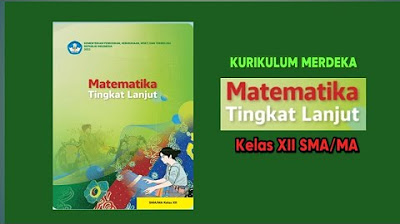Konsep Limit Matematika dalam Kehidupan Sehari-Hari - Kelas 12 SMA
Summary
TLDRIn this video, the speaker explores the concept of limits in mathematics, emphasizing its importance in various fields such as meteorology, economics, biochemistry, and physics. Through a simple example of the limit of a function, the speaker explains how limits represent the value a function approaches as the input nears a particular point. The concept is crucial for understanding derivative calculus and solving real-world problems like weather prediction, stock investments, disease spread, and calculating instantaneous speed and acceleration. The video introduces the formal and informal definitions of limits and encourages viewers to explore further.
Takeaways
- 😀 The concept of approximation and uncertainty is common in daily life, leading to the use of rounding in measurements and predictions.
- 😀 There is no 100% accuracy in any value, and errors or uncertainties are always present in various fields like weather forecasting and economics.
- 😀 The concept of 'limits' in mathematics helps to describe how values approach certain points, providing a formal way to handle uncertainty in mathematical functions.
- 😀 The formal definition of a limit describes how a function behaves as the variable approaches a specific value, but an intuitive or informal understanding of limits is often easier to grasp.
- 😀 The notation for limits is 'lim (x → a) f(x) = l', which means the function approaches a value 'l' as x approaches 'a'.
- 😀 The limit of a function can be determined by checking its behavior as the variable approaches the value from both the left and right sides.
- 😀 If the left-hand and right-hand limits at a point are the same, the function has a limit at that point; otherwise, it does not.
- 😀 An example of a limit is the function f(x) = x + 1 as x approaches 2. The function approaches 3 as x gets closer to 2 from both sides.
- 😀 Limits are widely used in fields like meteorology (for weather predictions), economics (for demand and supply functions), and biochemistry (for population studies of bacteria or viruses).
- 😀 In physics, limits help calculate instantaneous speed and acceleration of moving objects, among other phenomena.
- 😀 Understanding limits is crucial for various real-world applications, including predicting weather patterns, determining the spread of diseases, and solving problems in physics and economics.
Q & A
Why is rounding often used in everyday life when measuring or calculating something?
-Rounding is used because there are no 100% accurate values in measurements or calculations. There will always be errors or uncertainties due to limitations in precision.
How is the concept of limits connected to the weather forecast, economics, and physics?
-Limits are used in various fields to model real-world phenomena. For example, in meteorology, limits help predict the weather, in economics, they assist in determining demand and supply functions, and in physics, they calculate instantaneous speed and acceleration.
What is the formal definition of a limit in mathematics?
-The formal definition of a limit states that the limit of a function fx as x approaches a value 'a' is equal to 'l' if and only if fx approaches 'l' as x gets closer to 'a' from both sides.
What does the notation 'lim x -> a' represent in the context of limits?
-'lim x -> a' represents the limit of a function as x approaches the value 'a'. The function value approaches 'l' as x gets closer to 'a'.
What is the intuitive understanding of a limit in mathematics?
-Intuitively, the limit of a function is the value that the function approaches as the input (x) gets closer to a certain point. It focuses on the behavior of the function near that point rather than its exact value at that point.
In the example given, what happens to the function f(x) = x + 1 as x approaches 2?
-As x approaches 2 from both the left and the right, the function f(x) = x + 1 approaches the value of 3, meaning the limit of the function as x approaches 2 is 3.
What happens if the limit of a function from the left and right is different at a certain point?
-If the limit of a function from the left and right at a certain point is different, the function does not have a limit at that point.
What fields of study use limits in their applications?
-Limits are used in various fields, including meteorology, climatology, geophysics, economics, biochemistry, medicine, and physics. For example, limits help predict weather, calculate demand and supply, and determine the spread of diseases.
How are limits applied in the field of economics?
-In economics, limits are used to calculate the supply and demand functions, model economic behaviors, and even predict stock market trends.
Can limits be used to predict the spread of diseases? If so, how?
-Yes, limits are used in biochemistry and medicine to model the population of bacteria or viruses, track their spread, and predict the course of a pandemic based on mathematical functions.
Outlines

此内容仅限付费用户访问。 请升级后访问。
立即升级Mindmap

此内容仅限付费用户访问。 请升级后访问。
立即升级Keywords

此内容仅限付费用户访问。 请升级后访问。
立即升级Highlights

此内容仅限付费用户访问。 请升级后访问。
立即升级Transcripts

此内容仅限付费用户访问。 请升级后访问。
立即升级浏览更多相关视频

Hakikat, Defenisi dan Kegunaan Matematika

Matematika tingkat lanjut kelas XII (12) SMA /MA Kurikulum merdeka @GUcilchaNEL1964

ĐẠO HÀM và ý nghĩa hình học (Derivative Intro) | Vật Lý Chill

Model Pembelajaran Seni Terpadu, Pengertian, Tujuan, Konsep, dan Contoh serta Analisisnya

ME-1.1 Apa Itu Sains Atmosfer & Meteorologi ? | Perbedaan Cuaca & Iklim | Kebumian Geografi

Seminário "Introdução à Modelagem Computacional" - Acadêmico Murilo Saraiva
5.0 / 5 (0 votes)
